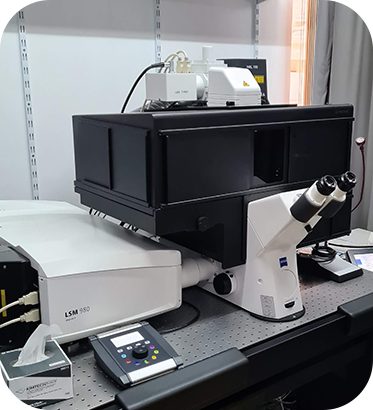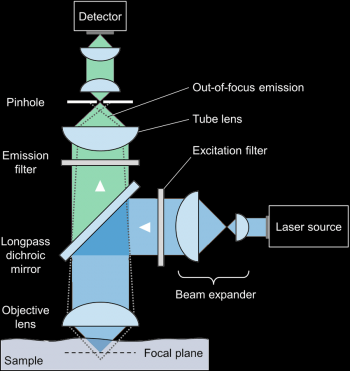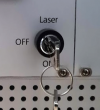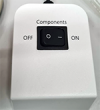This is an old revision of the document!
Table of Contents


|
Location: Room P2-A-24 ( |
Microscope overview
 The Zeiss LSM 980 with Airyscan 2 is a point-scanning confocal microscope able to generate high-resolution three-dimensional images of thick specimens with high sensitivity, high speed and low photodamage. It is an inverted microscope especially suitable for live cell imaging and photobleaching experiments, equipped with a dark large cage incubator and a stage top incubator for temperature control and CO2 supply and with Definite Focus.3 for hardware focus control during long time-lapse acquisitions. The stage is motorized and furthermore equipped with a piezo for Z displacement so fast 4D imaging is possible in multiple stage positions, using the Tiles Advanced Setup of ZEN blue. Its Airyscan 2 with 32 concentrically arranged GaAsP detection elements is able to collect all light from an Airy pattern simultaneously, allowing for increased resolution (120 nm laterally and 400 nm axially in SR mode, at 488 nm). It can also be used in Multiplex Mode, which enables parallel excitation and detection in 4Y or 8Y modes. The result is a speed improvement by a factor of 4x/8x, while maintaining the sensitivity of Airyscan. Its scanning unit further includes two PMT detectors as well as a GaAsP detector for increased sensitivity (45% QE compared to ~25% QE for conventional PMT). It is equipped with lasers from violet to far red (405, 488, 561 and 639 nm excitation wavelengths). With this system you can perform optical sectioning of fluorescent samples which are too thick for a widefield system such as the Zeiss Cell Observer. Image resolution with Airyscan 2 is higher than the Zeiss LSM 710 and detection sensitivity is also higher than the spinning disks 3i Marianas SDC and Zeiss Cell Observer SD. If your personal computer cannot handle all the data you collected, check out the Colossus.
The Zeiss LSM 980 with Airyscan 2 is a point-scanning confocal microscope able to generate high-resolution three-dimensional images of thick specimens with high sensitivity, high speed and low photodamage. It is an inverted microscope especially suitable for live cell imaging and photobleaching experiments, equipped with a dark large cage incubator and a stage top incubator for temperature control and CO2 supply and with Definite Focus.3 for hardware focus control during long time-lapse acquisitions. The stage is motorized and furthermore equipped with a piezo for Z displacement so fast 4D imaging is possible in multiple stage positions, using the Tiles Advanced Setup of ZEN blue. Its Airyscan 2 with 32 concentrically arranged GaAsP detection elements is able to collect all light from an Airy pattern simultaneously, allowing for increased resolution (120 nm laterally and 400 nm axially in SR mode, at 488 nm). It can also be used in Multiplex Mode, which enables parallel excitation and detection in 4Y or 8Y modes. The result is a speed improvement by a factor of 4x/8x, while maintaining the sensitivity of Airyscan. Its scanning unit further includes two PMT detectors as well as a GaAsP detector for increased sensitivity (45% QE compared to ~25% QE for conventional PMT). It is equipped with lasers from violet to far red (405, 488, 561 and 639 nm excitation wavelengths). With this system you can perform optical sectioning of fluorescent samples which are too thick for a widefield system such as the Zeiss Cell Observer. Image resolution with Airyscan 2 is higher than the Zeiss LSM 710 and detection sensitivity is also higher than the spinning disks 3i Marianas SDC and Zeiss Cell Observer SD. If your personal computer cannot handle all the data you collected, check out the Colossus.
![]() Data files older than 1 month will be automatically deleted on this system, please copy your data to the iMM server using the desktop link.
Data files older than 1 month will be automatically deleted on this system, please copy your data to the iMM server using the desktop link.
Additional information
Booking Rules
- Users can book at maximum 8 hours per week
- This usage restriction does not apply for weekends and for working days before 9:00 and after 21:00
- Exceptions to these rules require approval from José Rino.
System components
LASERs
| Laser Unit | Wavelength | Maximum Power |
|---|---|---|
| 405 | 405 nm | 15 mW |
| 488 | 488 nm | 13 mW |
| 561 | 561 nm | 13 mW |
| 639 | 639 nm | 10 mW |
Objectives
| Magnification | Model | Immersion | NA | WD (mm) | Reference |
|---|---|---|---|---|---|
| 10x | EC Plan-Neofluar | Air | 0.30 | 5.20 | 420340-9901-000 |
| 20x | Plan-Apochromat | Air | 0.80 | 0.55 | 420650-9903-000 |
| 40x | LD C-Apochromat Corr | Water | 1.10 | 0.62 | 421867-9970-000 |
| 63x | Plan-Apochromat DIC | Oil | 1.40 | 0.19 | 420782-9900-799 |
LEDs (Ocular)
| Line | Wavelength |
|---|---|
| UV | 405 nm |
| B | 475 nm |
| G | 555 nm |
| R | 630 nm |
Filterset (Ocular)
| Position | Filterset | Reference | Excitation | Dichroic | Emission |
|---|---|---|---|---|---|
| 1 | QUAD | FS90HE | 370-400 nm | 405 nm | 410-440 nm |
| 450-488 nm | 493 nm | 499-529 nm | |||
| 540-570 nm | 575 nm | 580-605 nm | |||
| 615-648 nm | 653 nm | 659-759 nm |
Microscope Turn On Procedure
The system should be always on, you should only need to turn on the computer, log into Windows and start ZEN.
If the system is completely off (e.g. during weekends), please follow this procedure:
- Turn on the
MAIN SWITCH
- Turn on the
Laserkey
- Turn on the computer
- Log into Windows with your Agendo credentials
- Turn on the
COMPONENTSswitch
- Start the ZEN software
Microscope Turn Off Procedure
Please do not shutdown the system. Just exit the ZEN software, log off Windows and shutdown the computer. Don't forget to clean immersion objectives!
 Zeiss LSM 980 Usage Statistics
Zeiss LSM 980 Usage Statistics

